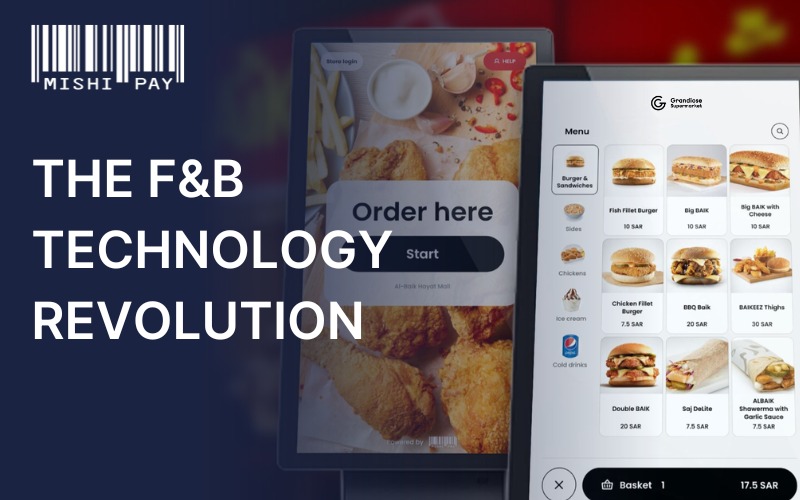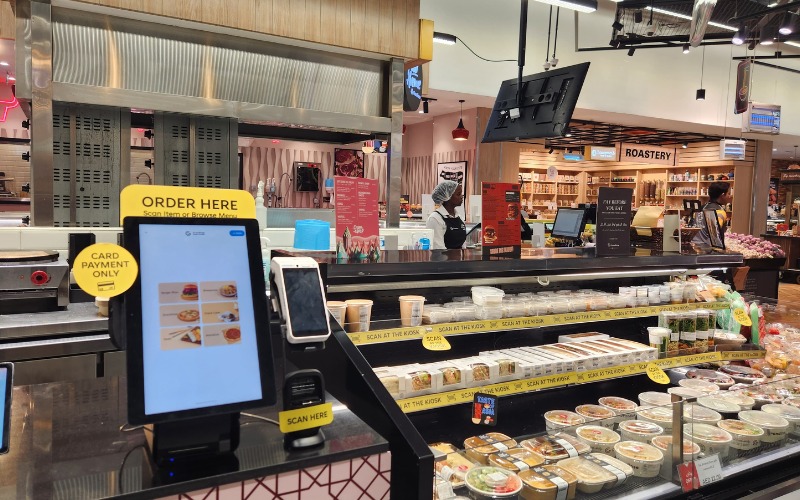The F&B Technology Revolution: From Cash Registers to AI-Powered Experiences
July 16, 2025

Share this with your colleagues
How the Food & Beverage Industry Transformed from Analog to Digital—And Why Their Patient Approach Created the Perfect Storm
The journey from paper tickets to personalized digital experiences: How the food industry’s measured tech adoption sparked a $30 billion transformation
The Early Days: When Food Service Was Purely Analog
The food service industry began its technological journey in the most basic way possible. In the 1970s and 1980s, restaurants operated on cash registers, paper order tickets, and manual inventory systems. The most “advanced” technology was the introduction of credit card machines, which many establishments resisted due to processing fees and slower transaction times.
During this era, the industry was built on human interaction at every touchpoint:
- Orders were taken by hand on paper pads
- Kitchen communication relied on physical tickets and verbal calls
- Inventory tracking was done manually with clipboards
- Customer loyalty was maintained through recognition, not data
Fast-food chains revolutionized operations with assembly-line efficiency, but even the largest burger chains relied on human cashiers and basic point-of-sale systems that did little more than calculate totals and process payments.

The First Wave: Point-of-Sale Evolution (1990s-2000s)
The 1990s brought the first significant technological shift with computerized point-of-sale (POS) systems. These systems moved beyond simple cash registers to offer:
- Digital menu programming and price management
- Basic inventory tracking
- Simple reporting capabilities
- Integration with credit card processing
However, customer-facing technology remained minimal. The industry’s conservative approach meant that while retail sectors experimented with self-checkout, food service maintained traditional counter service models.
The Mobile Revolution Begins (2000s-2010s)
The introduction of smartphones and mobile internet created the first real disruption in food service technology. Early adopters began experimenting with:
Online Ordering Systems
Pizza chains led the charge, with major brands launching web-based ordering platforms as early as 2007. This marked the first time customers could interact with restaurant technology directly, bypassing human intermediaries.
Mobile Apps and Loyalty Programs
The largest coffee chains pioneered mobile payment systems and digital loyalty programs, showing the industry that customers were ready for tech-enabled experiences. By 2011, mobile payments in coffee shops demonstrated that convenience could drive adoption.
Kitchen Technology Advances
Behind the scenes, restaurants began adopting:
- Digital kitchen display systems are replacing paper tickets
- Automated cooking equipment with timers and temperature controls
- Basic inventory management software
- Scheduling and labor management systems
The Self-Service Awakening (2010s)
While other retail sectors rushed to deploy self-checkout systems in the early 2000s, the food and beverage industry took a more measured approach. The reasons seemed obvious: food service is inherently social, orders are complex and customizable, and transactions require more interaction than scanning barcodes.
The world’s largest burger chain began testing kiosks as early as 2003, but it took until 2015 to commit to rolling them out across all 14,000 U.S. restaurants. This cautious approach, once seen as conservative, now appears prescient.
Lessons from the Struggle: What Resistance Taught the Industry
The food and beverage industry’s difficult journey with self-service technology offers profound lessons about technology adoption and customer behavior evolution:
Resistance as Innovation Catalyst
Early customer resistance wasn’t a barrier to overcome—it was market research in real-time. Every frustrated customer interaction provided direct feedback that drove interface improvements, processing speed enhancements, and feature development. The technology succeeded precisely because it initially failed.
Timing Technology with Behavior
The smartphone revolution created a generation of users comfortable with complex touchscreen interactions. F&B operators who waited until 2015-2020 to scale their deployments benefited from customers who had been “trained” on intuitive interfaces through their devices.
Ecosystem Maturity Matters
Early kiosks failed partly because supporting technologies hadn’t matured. Modern success relies on cloud computing, advanced payment processing, real-time kitchen integration, and mobile connectivity—technologies that simply didn’t exist or weren’t reliable enough in the early 2000s.
Evolution Over Revolution
Rather than forcing customers to adapt to technology, successful implementations adapted technology to match evolving customer expectations. The result: solutions that enhance rather than complicate the ordering experience.
The Digital Acceleration Era (2020s-Present)
The convergence of mature technology, changed customer expectations, and operational pressures created the perfect storm for widespread adoption.
The Kiosk Revolution
After years of cautious experimentation and industry skepticism, 2024 marked a watershed moment for self-service technology in food and beverage. The world’s largest burger chain deployed over 130,000 kiosks worldwide, with the technology boosting sales by 11% and sparking industry-wide adoption. During the third quarter of 2024, digital orders accounted for over 40% of sales in the chain’s top markets, demonstrating the massive shift toward self-service ordering.
Multi-Brand Portfolio Success
The restaurant kiosk market experienced explosive growth, with deployments surging 43% from 2021 to 2023, reaching 350,000 units globally. Industry leaders reported significant digital transformation success, with major fast-food chains expanding their kiosk presence internationally across countries from Romania to Southeast Asia.
Breaking Traditional Barriers
Perhaps most significantly, Starbucks announced its first-ever self-service kiosks in Korea and Japan in May 2025, starting with approximately 10 cafes in Seoul’s Myeong-dong district as part of a trial program. For a company built on the “third place” philosophy and barista interaction, with over 1,900 stores in Korea alone and 23,000 employees, this represents a seismic shift in industry thinking about technology and human connection.
The Economic Transformation
Shake Shack CFO Katie Fogertey reported that kiosks have become the chain’s largest order channel, with new interfaces developed by the company’s marketing team ” to help guide the guest through that order experience and focus more on the opportunity to trade up to a double, add bacon – really great ways that our guests can customize their menu items. The company found that kiosks have become the highest-margin channel for the brand, with guests ordering via kiosk generating higher checks because orders are more likely to include premium items and add-ons.
The financial performance of F&B technology implementations demonstrates remarkable success:
Market Growth
The global self-service ordering kiosk market reached $29.6 billion in 2024, with projections showing exponential growth to $48.1 billion by 2031. The broader self-service kiosk market was valued at $34.4 billion in 2024 and is expected to reach $37.2 billion in 2025, with a compound annual growth rate (CAGR) of 10.9% expected through 2030.
Operational Impact
- Revenue Growth: The first major burger chain to deploy kiosks saw a 5-6% increase in sales in the first year, followed by 2% growth in the second year
- Customer Spending: Self-service kiosks typically increase average transaction values by 20-30% compared to traditional counter ordering
- Market Dominance: Food ordering represents 37% of the total self-service kiosk market share, making it the dominant segment
- Employment Impact: Despite widespread automation fears, the quick-service restaurant industry has added jobs, with employment levels 3% above pre-pandemic figures
The Future of Food Service Technology: AI and Automation
Looking ahead, the industry continues evolving toward:
- Hyper-personalization through AI and machine learning
- Seamless omnichannel experiences across mobile, kiosk, and traditional ordering
- Sustainability integration with technology, optimizing waste reduction and energy usage
- Community connectivity through social features and local partnerships
“Together with our new Subway app and refreshed loyalty programme, kiosks are helping create an even more seamless and convenient guest experience. Guests can now quickly and easily browse the menu, customise their subs and earn Subway Rewards all in one place.”
Subway EMEA President Carrie Walsh
Conclusion: From Skeptic to Success Story
The food and beverage industry’s journey with technology proves that timing matters as much as innovation. By resisting the urge to be first-to-market and instead focusing on being first-to-get-it-right, F&B operators have created the most successful self-service implementation across any retail sector.
The industry that was once skeptical of technology has become its biggest advocate—and for good reason. The combination of improved technology, evolved customer expectations, and thoughtful implementation has turned what many viewed as a necessary evil into a genuine competitive advantage. For technology providers and other retail sectors watching F&B’s success, the lesson is clear: sometimes the tortoise really does win the race.
As the restaurant industry continues its digital transformation, the success of technology integration provides a roadmap for thoughtful adoption that enhances rather than replaces the human elements that make dining experiences memorable, while creating new opportunities for efficiency, personalization, and growth that would have been impossible in the analog era.
Sources and References
- McDonald’s Digital Sales and Kiosk Statistics
- McDonald’s Kiosk Deployment Impact
- Restaurant Employment Data
- Starbucks Korea Kiosk Trial Program
- Starbucks Korea Store Count
- Global Self-Service Kiosk Market Size
- Restaurant Kiosk Growth Statistics
- Self-Service Kiosk Market Analysis
- Food Ordering Market Segment Data
- McDonald’s Sales Performance Data